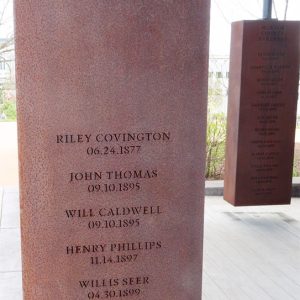calsfoundation@cals.org
Albert Blazes (Lynching of)
aka: Albert Blades (Lynching of)
In May 1926, an African-American man named Albert Blazes (sometimes referred to as Blades) was taken from authorities in Wilson (Mississippi County) and lynched for allegedly attacking a white girl. The story was covered both nationally and internationally, appearing in Time magazine and meriting a front-page illustration in Le Petit Journal, published in Paris, France. There is no information on the identity of either the girl or the alleged perpetrator.
According to the May 27, 1926, Arkansas Gazette, a group of Wilson school children were on an outing when three girls became separated from their classmates. Albert Blazes (whose age is reported in various sources from nineteen to twenty-two) pursued them; two of them ran away, but one girl tripped, and he seized her. She screamed for someone to help her, and Blazes ran away. The authorities pursued him with bloodhounds, and when they found him, he denied being involved. One of the teachers, however, identified him, and he was taken into custody.
Sheriff J. A. Bass and two deputies held Blazes in a warehouse, pending his removal to Osceola (Mississippi County) or Blytheville (Mississippi County), where he could be better protected. A mob approached and demanded Blazes. Overpowering the officers, they took him away, supposedly north of town, and when they reappeared without him, the sheriff assumed he had been lynched. Other accounts indicate that Blazes had been hanged and his body mutilated. According to Bass, “The mob was very orderly, and…after the negro was disposed of…came back home and went to bed.” He added that everything was quiet, “as though the episode had been forgotten once it was done.” Newspapers estimated the mob at anywhere from several hundred people to 1,200 or even 2,000. Several publications, including Time magazine, noted that there were women as well as men in the crowd.
According to the rather dramatic account in Time, on the moonless night of the lynching, the sheriff and his deputies were “sitting in an empty warehouse in Wilson…smoking meditatively…[while] at one side, in a huddle of shadow, lay a young man.” The man, Blazes, had allegedly attacked a white girl—“anyway, the girl said it was a Negro who attacked her, and Albert Blazes was a Negro.” According to Time, “The sheriff was holding him until he got what was coming to him; he must know what that was.…Darkly, softly borne on the dark soft air, a noise of voices reached the warehouse, tumbled cries, deep and shrill blended together, struck through with the note of an automobile horn continuously blowing. They were in the lane, they were coming up the hill, they were at the door.” According to this account, Blazes was hanged from a beam in the warehouse itself, a familiar sight to the officers. “Yet when at length the body stopped twitching and the last masked executioner went home to bed, the sheriff and his men lingered in the warehouse, talking about a variation which distinguished this lynching from all other lynchings of their experience. It was hard to believe, but in fact among the hangers had been several women.”
For additional information:
Illustration. Le Petit Journal Illustre (Paris), June 13, 1926.
“In Arkansas.” Time, June 7, 1926, pp. 8–9.
“Negro at Wilson Probably Lynched.” Arkansas Gazette, May 27, 1926, p. 1.
“Negro Charged with Attack, Hanged by Mob.” Clearwater (Florida) Sun, May 27, 1926, p. 1.
“Negro Is Hanged by Arkansas Mob.” Evening Star (Washington DC), May 27, 1926, p. 16.
“Negro Is Taken by Mob from Officers.” Ironwood (Michigan) Daily Globe, May 27, 1926, p. 1.
Nancy Snell Griffith
Davidson, North Carolina
 Civil Rights and Social Change
Civil Rights and Social Change Early Twentieth Century, 1901 through 1940
Early Twentieth Century, 1901 through 1940 Mississippi County Lynching
Mississippi County Lynching 




I’m from that area and did not know about this story. Thanks for the article and I will be looking more into this.